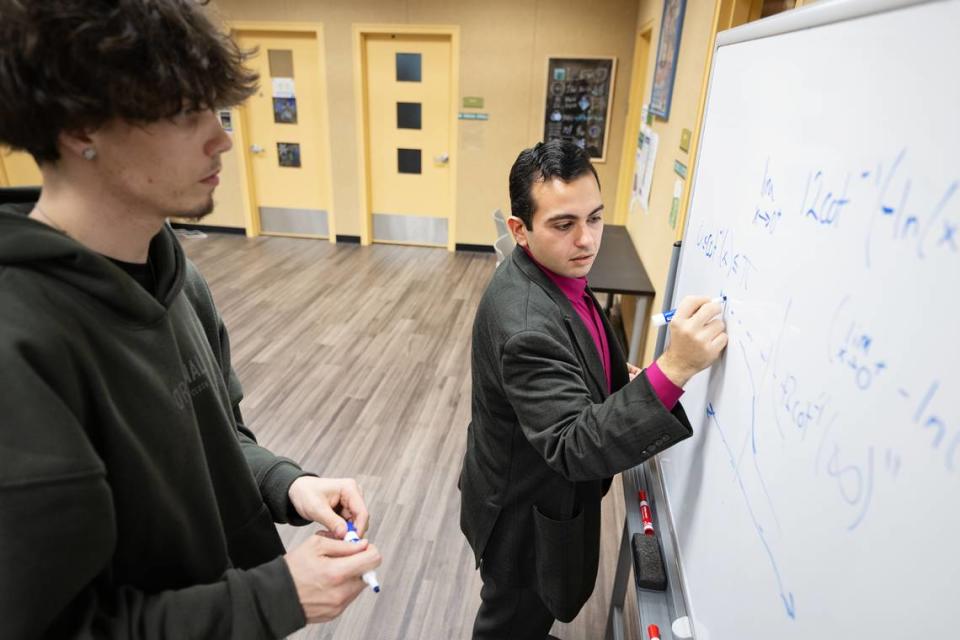Stanislaus County colleges behind in faculty diversity. What’s being done?
It wasn’t until Andrew Lazar reached college that he finally saw someone who looked like him in front of the classroom.
“When I had that Assyrian instructor for calculus, I saw myself having a future in that career,” said Lazar, a mathematics professor at Modesto Junior College. He was a student at MJC from 2015 to 2017 and started teaching there in 2021.
Though the majority of students at Stanislaus County colleges are people of color, there remains a significant gap in faculty representation.
In the most recent data, for the 2022-23 school year, students of color made up 75% of the population at MJC, whereas only 25% of faculty did. Similarly, at California State Stanislaus, 35% of faculty are from underrepresented backgrounds, while 82% of students are.
One contributing factor is the tenure system, which grants permanent positions to academics, making it challenging to diversify faculty at a quicker rate without retirements or vacancies.
Nevertheless, fostering diversity in higher education is crucial for student achievement and for fostering a culture of inclusivity within academia.
Lazar recalled a time when a student came up to him and revealed that he, too, Assyrian. The student’s excitement over their shared heritage was palpable, and they exchanged greetings in their native language.
For Assyrian Americans, who are part of a diaspora community, Lazar said it felt like meeting a family member. “I think I know what it’s like on the other side now,” said Lazar. “It’s those experiences that truly mean a lot.”

There’s measurable student impact
Research shows a strong correlation between higher rates of faculty diversity and increased graduation rates among students from underrepresented minority groups.
Gisele Flores, a professor of child development at MJC, said the impact of seeing oneself represented in instructors and realizing the attainability of a college degree cannot be overstated.
Because most of her students are Latino, she can speak to them in Spanish and doesn’t feel the need to change her speaking style. “I think it opens up doors and windows and roofs,” Flores said.
Similarly, Duana Demus Leslie, who teaches music at MJC, said she integrates her African American background into her curriculum. She introduces her students to a variety of genres, including songs by Earth, Wind & Fire and from the musical “Hamilton.”
When Leslie first started teaching, she was the only female African American with a PhD at MJC. Now she can name three other Black women there who also have their doctorates.
“I feel like more and more diversity has been happening but there still needs to be a lot more,” Leslie said.
Nurturing the next generation of faculty
Kris Roney, associate vice president for faculty affairs at Stanislaus State, said the Chancellor’s Doctoral Incentive Program at the university helps prepare doctoral students for CSU faculty positions by providing financial support, mentoring and professional development and grant resources.
MJC President Brian Sanders noted that many former MJC students have joined the faculty over the years. “These students reflect the diversity of our community and we’re thrilled to have them back as our professors,” he said.
Similar to Lazar, Flores didn’t encounter a teacher of color until she got to MJC. She said it felt intimidating to enter a space where no one looked like her.
Drawing from her own experience as a former MJC student, Flores said she feels better equipped to connect with her students and to show them that anything is possible.
“They see me as someone who knows their experience,” she said.
Diversity-minded recruitment
Diversifying staff begins with the job posting.
Roney said Stan State prioritizes inclusive language in its job advertisements and discusses mitigating bias within hiring committees.
During candidate interviews, Roney said committee members strive to pose thoughtful and equitable questions. They share listings to programs, like the PhD Project, which aims to support individuals of color in academia, and find relevant conferences to advertise job openings to attract a diverse range of candidates.
Sanders said MJC uses an equity-minded framework in its hiring process. One of the qualifications sought in prospective candidates is the ability to thrive in the college’s diverse environment and to help students from all backgrounds succeed in the coursework.
“Our goal is to move our faculty demographics to more closely align with those of our students,” Sanders said. “This is a slow process.”
Retaining educators of color
Besides recruitment efforts, maintaining a diverse workforce hinges on retention.
In the K-12 education sector, teachers of color face notably higher turnover rates, with 19% departing annually, compared to 15% among their white counterparts.
MJC’s Flores said she dealt with a lot of imposter syndrome when she first started teaching because no one looked like her.
CSUS has affinity groups, such as the Chicanx Latinx Faculty and Staff Association, which provide a platform for social interaction, networking and support within the community among staff.
At MJC, newly hired faculty members are paired with mentors who serve as guides on their path to tenure, fostering a sense of inclusion and belonging.
Shirley Miranda Brenes, an English professor at MJC, said having a diverse administration is just as important as the faculty itself. She appreciates the sense of community and strong mentorship at MJC.
“We are not where we would like to be, but we’re definitely not where we were,” Brenes said.
Twenty years ago, when she was a student, she didn’t remember MJC having any full-time Latino or Black professors. Despite her hesitation about pursuing a career in education, one of her mentors told her to get her master’s degree in teaching because she would be a mirror to other young Latinas.
Recently, one of her former students emailed her and told her she wants to come back to teach at MJC.
“We have made some great progress and we just need to continue to work hard to increase that diversity,” Brenes said.


